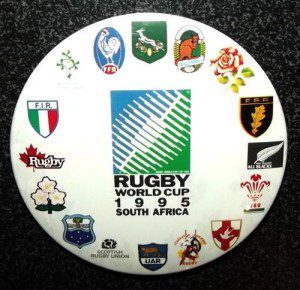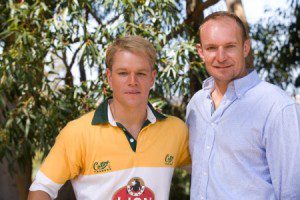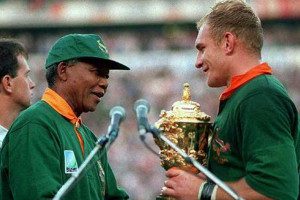In preparation for the 2015 Rugby World Cup, Rugby Rain Man Collective member Ryan Day is providing match reviews and analysis of all the Rugby World Cup games in USA Rugby history.
Note: We at Rugby Wrap Up are missing the article for Part 6 of the England-USA match from the 1991 Rugby World Cup because video of the match cannot be found on the internet from multiple sources. If you have video of this game, or are aware of where it exists, please let us at Rugby Wrap Up know where we can find it or send to us. Many thanks!

Ft. Wayne, IN – A lot of change occurred in the sport of rugby union between the 1991 and 1995 Rugby World Cups. In April 1992, the International Rugby Football Board (later the International Rugby Board and now World Rugby) voted to increase the value of tries from four to five points. Also in 1992, South Africa, which missed the first two World Cups as part of the global boycott of the country in sport due to the nation’s apartheid political system, was readmitted to rugby union’s good graces in the aftermath of the fall of the apartheid system.

The IRFB in 1992 also voted for South Africa to host the 1995 Rugby World Cup, marking the first time there would be no co-hosting for the World Cup. Since South Africa was not in the 1987 or 1991 Rugby World Cups and the number of countries participating were to remain at 16, a spot had to be taken from somewhere for them to compete, which negatively affected the U.S.
To explain this, we need to go back to 1991. The eight quarterfinalists from 1987 automatically qualified for the 1991 Rugby World Cup. Those eight teams were the Five Nations of Europe (England, Scotland, Ireland, France, Wales), Australia, New Zealand, and Fiji. Everything went to form with the Fijians being the outsiders of sorts. The remaining spots in the 1991 Rugby World Cup were partitioned for 1 African qualifier (Zimbabwe), 2 Asia/Oceania qualifiers (Western Samoa and Japan), 2 European qualifiers (Italy and Romania), and 3 Americas qualifiers. For these 3 qualifying spots from the Americas, 3 teams entered: Canada, Argentina, and the United States.
It was a home-and-away round robin where the teams were guaranteed entry into the 1991 RWC but were playing for seeds where the better the seed, the easier the competition come World Cup time. Canada won the double round robin with a record of 3-1, sweeping Argentina and splitting with the U.S., allowing them to take the Americas 1 seed. The U.S. took 3rd behind Argentina with a record of 1-3. The games were very tight – the widest margin of victory in any game was Canada defeating the U.S. 21-3 in Toronto in September 1989. For the 1991 RWC, Canada was in a pool with France, Romania, and the weakest quarterfinalist from 1987, Fiji. Against this opposition, Canada defeated Romania and Fiji and lost a tight game to France 19-13 to qualify for the quarterfinals. In the quarterfinals, Canada respectably lost to New Zealand 29-13 in the best performance by a team from the Americas in the Rugby World Cup until Argentina’s 3rd place in 2007. Argentina, like the U.S., went 0-3 in World Cup pool play.
Once 1995 RWC qualifying started, Canada were automatic qualifiers based on their performance in 1991. Western Samoa upset Wales in a famous game in Cardiff in 1991 to garner a quarterfinals spot at the expense of the Welsh. Accounting for South Africa automatically qualifying as hosts, there were 7 qualifying spots available. Europe was increased to 3 spots from 2 to account for Wales falling into qualifying. Africa stayed at 1 spot (Zimbabwe were replaced by the Ivory Coast). Asia/Oceania went from 2 combined to 1 each (Fiji were replaced by Tonga), and the Americas went down to 1 qualifying spot. So considering the automatic qualification of Canada, the Americas lost a place to account for the entry of South Africa and either the U.S. or Argentina would not qualify. North and South America had separate qualifying into a final. For Argentina, this meant they had to win a 4-team tournament vs. Uruguay, Paraguay, and Chile. For the U.S., they had to go defeat Bermuda.
In a one-off match in Hamilton, Bermuda, on March 12th, 1994, the Eagles won 60-3. Eight players for the Eagles scored tries with fly half Chris O’Brien scoring two. This was the last test match in the careers of O’Brien and wing Gary Hein.
The Eagles then prepared to play Argentina in a two-legged home-and-away contest. The first match was at George Allen Field in Long Beach on May 28th, 1994. The Eagles were captained by lock Kevin Swords against an Argentinian team led by center Marcelo Loffreda. In a tight contest, Argentina won their away match 28-22. Both teams scored 3 tries and had 2 conversions, but Argentina had more penalty kicks, 3-1. One of the Eagle tries was scored by wing Vaea Anitoni, who is currently the all-time leading try scorer in United States test rugby match history with 26. The other two tries were scored by scrum half Andre Bachelet and wing Tomasi Takau, making his debut. The two conversions and one penalty were scored by fly half Mark Williams.
A month later, the Eagles went down to Buenos Aires trying to overcome a 6-point deficit. The captaincy this time, according to Scrum Statsguru, transferred from Swords to Bachelet. Two changes were made to the lineup from the match in Long Beach, with Bill Leversee replacing Rob Randell at lock and Ben Hough replacing Chris Campbell at flanker. Eagles played the match tight again but lost 16-11, losing the overall series 44-33. Takau scored the lone try for the Eagles with Williams adding two penalties. This was the last test match in Swords’ storied career.
As far as the “why?” on the Eagles not qualifying, without match video it’s hard to illuminate, but looking at the rosters there was a lot of turnover from the 1991 RWC. In 1991, there were a good number of veterans from 1987, but as was pointed out in the match commentary in the Italy match from the ’91 World Cup, the team was old with a lot of players the wrong side of 30. In this test match series with Argentina, the only RWC veterans were Swords, prop Chris Lippert, Williams, and Leversee, so there was an experience deficit there as the first generation of RWC talent had aged out of the game.

The 1995 Rugby World Cup would go on to become the most infamous edition of the tournament that has been played so far. South Africa upset Australia in the opening match of the tournament and rode that to the final where they were able to shut down Jonah Lomu and New Zealand to win on home soil with the full backing of President Nelson Mandela in a story dramatized by the Clint Eastwood film Invictus. The Eagles’ “American mates” Canada and Argentina did not go far. Canada went 1-2 defeating Romania; losing to Australia; and in their final pool match, losing to South Africa 20-0 (which was noteworthy for a brawl late in the match where Canada received two red cards and South Africa one). Argentina went 0-3 losing all three matches by six points to England, Western Samoa, and Italy. The 1995 Rugby World Cup would also be the last event before professionalism was allowed by the rugby union authorities. During the tournament, the formation of SANZAR (South Africa/New Zealand/Australia Rugby) was announced in part to stop the poaching of players by the Super League of Australia. SANZAR would start to administer Super 12 in 1995 and would also form an annual test match series between the three countries: the Tri-Nations.
That’s it for now! Feel free to comment below, look for and “Like” our Facebook Rugby Wrap Up Page and follow us on Twitter@: RugbyWrapUp, Junoir Blaber, James Harrington, Jamie Wall, Nick Hall, DJ Eberle, Jake Frechette, Scheenagh Harrington, Jamie Loyd, Cody Kuxmann, Karen Ritter, Audrey Youn, Akweley Okine, Rocky Brown and Declan Yeats, respectively.

